You can find me on
April 30, 2015
April 11, 2015
-
Nanoblock - Moai Statues of Easter Island
One of the gifts my sibling gave me from Christmas. I just got around to building it. The Moai Statues of Easter Island set is not too difficult to build and not too complex. It does require making 3 Moai heads.
These monolithic statues can be as tall as 33 ft. and as heavy as 86 tons. They were original carved from volcanic rock by colonizers of the Polynesian island between 1250 CE and 1500 CE. There's not much else written on the packing about the the Moai Statues, so I read up on the subject.
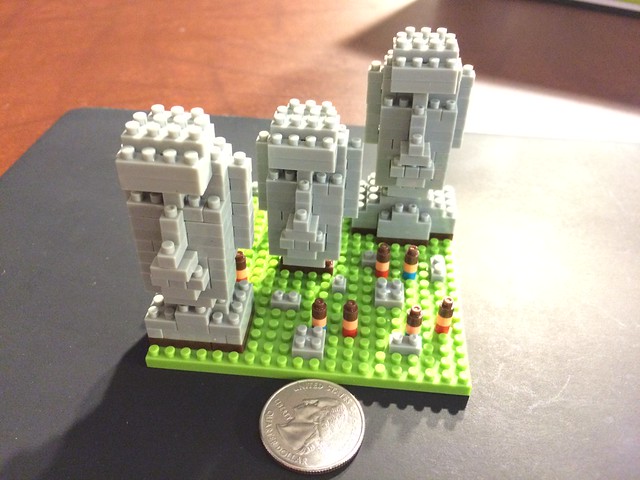
It is not known exactly how these statues were moved across the island from the origin of the volcanic rock they got it from and were remnants of these statues are located now. The Rapa Nui created them to represent deceased ancestors and former chiefs. Some time later in their civilization, the Rapa Nui lost order when they completely cut down all trees in the island. They could not build boats for fishing and food became scarce. Various tribes started fighting each other and toppled down statues of rival clans.
Today, about 50 of the 887 statues are intact and have been re-erected at the preservation site. 11 Moai statues have been removed from Easter Island and shipped to various museums and installations around the world to show this mysterious relic with a tragic connection to the now extinct Rapa Nui civilization.
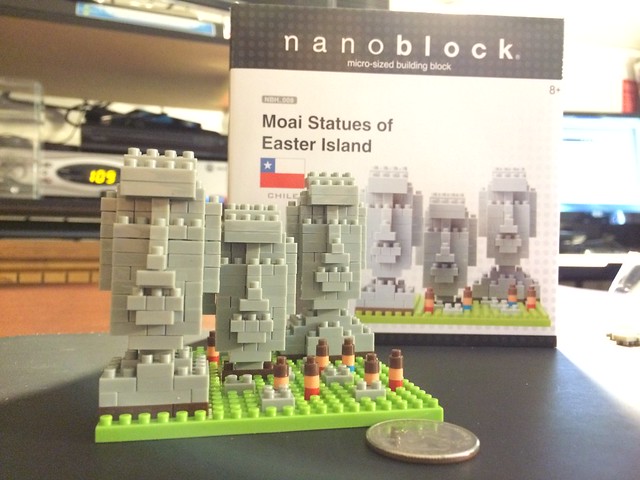
I'm done.
April 3, 2015
-
Stevie Wonder
My parents are watching Stevie Wonder for the Songs in the Key of Life concert in Baltimore next week. They asked me if I wanted to go back in February, but I declined. It's on Thursday and I don't know how busy work can get yet. I probably should have, though.
The first memory I have of Stevie Wonder is the "Part Time Lover" song. I was less than 5 years old and the song was catchy. I didn't understand the lyrics, but I still like it.
My mom asked me to burn her a CD of Stevie Wonder songs. She listed 28 songs, in order of which one can fit in one CD. I suggested to just make 2 CDs and add a few more songs. There are so many hit songs to choose from 5 decades worth of albums. "Overjoyed" and "Lately" are my favorites in all his songs. "Lately" I associate the most when I was 12 years old. The lyrics paint an infidelity story, but it's the chorus that touches me the most.
Well, I'm a man of many wishes
Hope my premonition misses
But what I really feel my eyes won't let me hide
‘Cause they always start to cry
‘Cause this time could mean goodbyeMy mom had to leave for a job here in the US and listening or hearing the song made me lonely. "Lately" is also one of her favorite songs.
So now, I have an iTunes full of Stevie Wonder songs

I'm done.
March 24, 2015
-
LEGO Architecture - Sungnyemun
This set is one of two very limited LEGO Architecture sets they've produced. Released in June 2012, it was only available for less than 9 months until the LEGO company retired the set. I managed to find a seller on eBay and bought it used.
Sungnyemun (Gate of Exalted Ceremonies) stands majestically in the heart of the South Korean capital of Seoul. Seen as one of the most complete examples of Joseon Dynasty architecture in South Korea, the gateway is listed as the country’s foremost National Treasure.
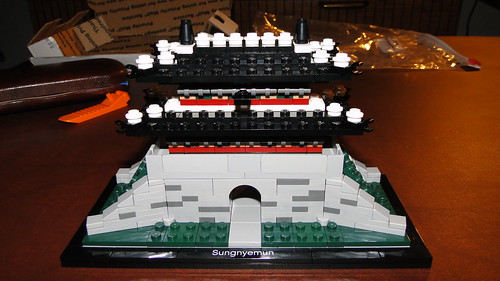
Historical Setting
By the time King Taejo established the Joseon Dynasty in the late 14th century, the country that we recognize today as Korea was a kingdom in turmoil. Ruled by the faltering Mongol Empire, under attack from Japanese pirates and weakened by political intrigues, the kingdom needed a strong leader. Yi Seong-gye, later to become King Taejo, was a talented general who repelled foreign threats, gained independence from the Mongols and established the “Kingdom of Great Joseon” in 1392.
One of his first actions was to move the capital to Hanseong (Seoul) and initiate a building program that included a 6.1 m (20 ft.) high and 18.2 km (11.3 mile) long wall to protect the growing city. Four major gateways were built into the wall to control access in and out of the city, and Sungnyemun would become the most impressive of these gates. Sungnyemun consists of an imposing stonework base and archway with a two-story wooden pagoda construction sitting above.
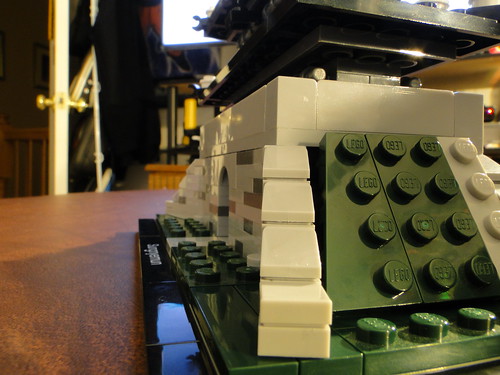
Construction
The construction of Sungnyemun began in 1396 during the fifth year of the reign of King Taejo of Joseon and was completed in 1398. Taejo had ordered his architects to build the gate facing Mount Gwanaksan as a way of warding off the feng-shui fire energy associated with the mountain.
Further additions were made to the gateway in 1447 by King Sejong, the 4th King of the Joseon Dynasty, and further work was carried out in 1479 by King Seonjong, the ninth King in the dynasty. It was at this point it was given the design that we still associate with the gate today. At that time Sungnyemun was already the finest of all the gateways intothe city, and the stone and two-tiered wooden structure with a pagoda-shaped tiled roof rose high above the rest of the city.
Further alterations and renovations continued over the next 600 years. The walls on both sides of the gate were removed in 1907 to make way for a tramway. During the Korean War (1950-1953) Sungnyemun suffered damage from bombing. In 1962 the gateway was officially designated as Korea’s first national treasure and an extensive reconstruction program was carried out.
During the work that was carried out on Sungnyemun in 1962, hidden records were discovered under a ridge beam of the second roof. These placed the precise date of the original construction as 1396 and went on to record that 6,817 soldiers were conscripted to perform the manual labor. The inventory also listed that twenty-eight stonecutters, forty-four carpenters, sixty-three riveters, and five sculptors, along with 1,400 laborers took part in the gate’s construction. The record even detailed the feast at the beam-raising ceremony: 10,700 bottles of Arak-Ju (Korean rice-based grain liquor), 3,800 barrels of Tak-Ju (traditional Korean wine), and 1,500 head of cattle.
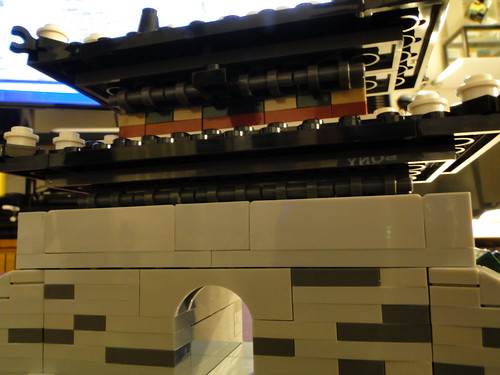
Sungnyemun Today
Once the tallest building in Seoul, today, Sungnyemun is surrounded by the skyscrapers and bustling traffic of a modern city. The gate provides a visible contrast between ancient and contemporary Korea, and is one of the few physical links to the Joseon Dynasty.
The pagoda building on top of Sungnyemun was the oldest existing wooden structure in Korea until February 10, 2008, when fire totally destroyed it. A complete restoration project began two years later in 2010 and it’s expected that an exact reproduction of the original will be completed by the end of 2012.
The entire reconstruction is being carried out using traditional methods. Conventional hand tools are made in a smithy set up on-site and workers wear ‘hanbok’, the traditional Korean costume, when working on the gate. As much timber as possible from the surviving frame is being recycled and put together with wood from dozens of pine trees to become pillars of the new structure.
A traditional ritual was performed at a ceremony prior to the start of construction, praying for a smooth restoration process as well as protection from further disasters to Korea’s most important National Treasure.
Facts about Sungnyemun
Location: Seoul, South Korea
Architect: unknown
Style: Joseon Dynasty
Construction type: City Gateway
Construction materials: Stone base with wooden structure
Date: 1396-1398, Rebuilt 1447 & 1479
Size:- Stone base - 28.97m x 14.79m
- (95.05 ft. x 48.52 ft.)
- Wooden structure - 22.29m x 7.65m
- (73.13 ft. x 25.1 ft.)
LEGO Architecture launches its model of Sungnyemun as a celebration of the EXPO 2012 exhibition in Yeosu, South Korea.
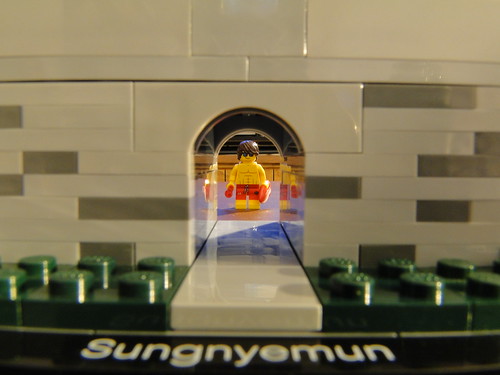
I'm done.
March 13, 2015
-
LEGO Architecture - First Three Sets
I recently obtained a retired LEGO architecture set (John Hancock Center). I decided to take apart the Willis Tower (Sears Tower) and Empire State Building sets and create a timelapse for it.
21000 - Willis Tower (Sears Tower)
The Willis Tower,located in the heart of Chicago, is an “international style” design consisting of square tubes in a 3 by 3 tube arrangement, with each tube having a footprint of 23 meters (75 ft.) by 23 meters (75 ft.), in essence creating a unified bundle of nine tubes. The Willis Tower was the first building for which this type of “bundled- tubular” construction was used. This design provides stability against high winds and also allows for future upward growth if so desired.
The building is supported by 114 rock caissons secured into bedrock. The foundation and the floor slabs combine to equal 2 million cubic feet of concrete. 76,000 tons of prefabricated steel frame sections measuring 15x25 ft. were put in place. The Willis Tower has more than 16,000 bronze-tinted windows and 28 acres of black aluminum cladding or “skin”.
As the building climbs upward, the tubes begin to drop off giving the Willis Tower its characteristic setback or “step-back”. This geometry of the 110-story tower was developed in response to the original interior space requirements of Sears, Roebuck & Company.

21001 - John Hancock Center
The John Hancock Center is one of the most famous buildings representing the structural expressionist style; the skyscraper's distinctive X-bracing and angular facade has made it an architectural icon not only in Chicago, but throughout the world.
The X-bracing exterior is actually a hint that the structure's skin is part of its tubular structural system. This "diagonalized trussed-tube" is essentially the spine that helps the building stand upright during wind and earthquake events. This is one of the architectural techniques building used to climb to record heights which eliminated the need for inner support beams, greatly opening up the floor plan and increasing the usable floor area.
The overall form can be described as truncated rectangular-pyramid. Shaped like a rhombus or rhomboid, and essentially a parallelogram with unequal adjacent sides in this case composed of four trapezoidal planes.

21002 - Empire State Building
During the Great Depression, America’s labor force was at its highest supply and the value of the dollar was cut in half over night. Ironically, it was this combination of events that made a construction project of this proportion possible.
Built on the previous site of the famous Waldorf Astoria Hotel, the construction took seven million man-hours and had a feverish pace of 41⁄2 floors per week.
Ironworkers erected 60 thousand tons of riveted steel frames into a series of stacked boxes. They became known as “Sky-walkers” due to the dizzying heights they worked at – heights never previously attempted.On May 1st, 1931, the building opened after only 410 days of construction and it remained the tallest building in the world until 1972 when the World Trade Center opened. The building has been named one of the 7 wonders of the modern world.

In case something happens with Xanga, you can follow me on WordPress, Blogger and Twitter. I'm pretty much everywhere. Just search for stupidsystemus

I'm done.
Archives
- April 2015 (3)
- March 2015 (3)
- February 2015 (9)
- January 2015 (2)
- December 2014 (4)
- November 2014 (5)
- October 2014 (3)
- September 2014 (3)
- August 2014 (5)
- July 2014 (3)